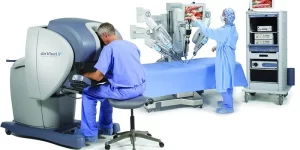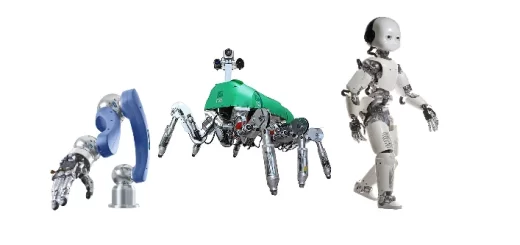Surgical robot types, advantages, disadvantages and how is robotic surgery different from traditional
A surgical robot is a surgical intervention in the human body that is not performed by a surgeon directly, but it’s based on mechanical robots which are programmed with computer technology and using commands and information that allow it to perform the surgery as planned without deviation from its plan or dealing with anything else in patient’s body.
What is Robotic Surgery?
It is an advanced form of minimally invasive or laparoscopic (small incision) surgery, surgeons use a computer-controlled robot to assist them in certain surgical procedures. The hand of the robot has a high degree of dexterity, It allows surgeons to operate in very tight spaces in the body that would otherwise only be accessible through open (long incision) surgery.
A surgical robot helps in all surgical operations that depend on laparoscopy in all specialties of endoscopy, robotic surgery does not aim to eliminate the conventional surgery that can be done by surgeons but is aimed at increasing the accuracy and capabilities of those surgeons.
Robotic surgery offers smaller incisions resulting in less pain and scarring. It enables surgeons to perform complex surgical tasks through tiny incisions using robotic technology, Surgical robot is a self-powered, computer-controlled device that can be programmed to help in the positioning and manipulation of surgical instruments, This provides surgeons with better accuracy, flexibility, and control.
When performing robotic surgery using the da Vinci Surgical System: The surgeon performs the surgery from a computer console in the operating room, He controls miniaturized instruments mounted on three robotic arms to make tiny incisions in the patient, The surgeon can examine through a 3-D camera attached to a fourth robotic arm, which magnifies the surgical site.
Robotic-assisted surgery allows you to receive sophisticated treatments with less downtime, It uses specialized technology to deliver precise care, Robotic surgery can treat conditions affecting your heart, digestive system, bladder, prostate, and more. Surgical robot enhances the capabilities of surgeon’s hands, It allows surgeons to perform procedures in hard-to-reach areas through small incisions, It enables precise movements and enhanced magnification.
Applications of robotic surgery
A surgical robot consists of surgical arms with tiny instruments with wrists at the tip, a special camera that provides enhanced magnified 3D views of the surgical area, and a surgical console where the surgeon controls the instrument & camera every move. The most important of those applications are Robotic surgery for obesity, Robotic surgery for Bowel, and Robotic surgery for general surgery.
A surgical robot is used for obesity surgery that is the safest and of the highest quality now, It reduces the chances of any surgical error or pain for the patient when removing that fatty part, and it will be performed through very small incisions. Robotic surgery is used in pancreatectomy and hepatectomy which have tumors and need surgical intervention.
Bowel surgery can be done well by laparoscopy, however, there will be some difficulties in penetration of the inner tissue and entering those depths, It is considered the most difficult due to the narrowing of the small cavities inside the intestine and within the pelvic region in the human body, A surgical robot increases the patient safety.
Robotic surgery can facilitate surgeries, especially the dangerous ones, that happened because of the high-tech imaging technology and some surgical equipment that can enter the abdomen of the patient through very small openings, with the ability to see the part to be treated using a 3D camera, you can distinguish between tiny vessels and nerves, which helps to move more precisely between them with a robotic arm.
Robotic surgery is appropriate for many types of procedures, Compared to the surgeon’s hand which has a ratio of error, the robotic arm can move anywhere inside a patient’s body without any error in the operation. Types of robotic procedures currently available include Heart surgery, Gastrointestinal surgery, Gynecologic Surgery, and Urologic surgery.
Advantages of surgical robots
Robotic surgery offers greater visualization, enhanced dexterity, and greater precision, With robot-assisted technology, surgeons have an enhanced view, A camera offers real-time, high-resolution, magnified images with 3D capabilities. complex surgical operations have become easier than before, many surgeries are done with the utmost ease and accuracy.
Robotic surgery reduces pain and discomfort during recovery, It reduces the risk of infection, It reduces blood loss and transfusions, It offers minimal scarring. Surgeons who have performed a high volume of these procedures typically deliver optimal outcomes. Recovery is much shorter, Depending on the procedure type and your overall health, you may get out of bed shortly after the anesthesia wears off, you can eat within a few hours of surgery, and you can go home the same day or the next day, and you can return to normal activities.
Robotic surgery offers higher accuracy in completing the operation, as the doctor’s hand may be unable to access to the smallest areas of the body, but surgical arms and robotic endoscopes offer undoubtful precision that helps it to reach the most accurate and sensitive areas during the surgery. Robotic surgery offers higher speed and it can save time up to 30% compared to conventional operations, so, more comfortable for the patient and surgeons.
Surgical robot arms are more flexible in their movement, the movements of the surgeon in the control unit can be translated into very precise and 3D flexible movements, the robot arm is more stable and steady in its movement when compared to the surgeon’s hand that might shake or be subjected to tremors, especially in the sensitive surgeries. Robotic surgery delivers excellent results and has a good success rate that ranges from 94% to 100%.
Robotic surgery has better visibility through the high-resolution and high-definition images on the screen and magnified as well, surgeons can see areas where they couldn’t be able to see before, and surgeons are depending on their own vision under the operating room lights in conventional surgeries. A surgeon standing up all the time, He is subjected to fatigue and less concentration, Surgical robots are machines and don’t know fatigue.
Robotic surgery can enter very sensitive and small sites with/ smaller incisions, minimal invasion, and less pain during the surgery when compared to conventional surgeries. Complications arising from anesthesia in robotic surgery are less than the complications resulting in cases of anesthesia as a result of other conventional surgeries.
With the emergence of 5G technology, ultra-high-speed connectivity enabled surgeons to perform telesurgery with less latency and almost real-time machine response. The 5G technology offers a high speed of data transfer, with almost 2 milliseconds lag between devices, this technology will have a massive application in healthcare and telesurgery is one of these applications. The first time to apply for telesurgery was in Beijing, China in 2019, it was a brain surgery over 1,500 miles away for a Parkinson’s disease patient.
Disadvantages of surgical robots
Robotic surgery is only available in centers that can afford the technology and have specially trained surgeons, the surgeon may need to convert to an open procedure with larger incisions when there are complications, Which include scar tissue from previous surgeries that make it difficult for robotic technology to complete the procedure, there is a risk of nerve damage and compression, Robotic malfunction, which is extremely rare.
Robotic surgery can’t move on its own, Surgeons are in control at all times, The surgical robot requires massive training for surgeons, There are not many experts who know how to perform robotic surgery, that’s why robotic surgery might not be widespread due to the lack of experts who can perform this kind of surgery. Robotic surgery lowers the risk of certain complications. But they’re still possible.
Your healthcare should include follow-up appointments to track your recovery, You can contact your healthcare provider immediately if you experience: Blood-soaked dressings, which can be a sign of excessive bleeding, Infections that cause a fever or yellowish discharge from your incision, Pain that doesn’t respond to medications, Signs of blood clots, such as abnormal swelling in your groin or lower leg, vomiting & not being able to keep fluids down.
Robotic surgery comes with high costs for providers and patients as well, a single surgical robot system might cost USD 2 million, so it’s not a budget-friendly solution, The continuous development of robotic surgery systems to improve the quality and add better functionalities makes the older versions obsolete and need to be replaced, which will increase the cost of robotic surgery systems.
Surgeons depend on their sense of surgery procedures, from their own experience they might feel if something is right or wrong depending on haptic feedback, Hepatic feedback is minimized and not noticeable in robotic surgery, that might increase the risk of injuring other organs or more nerve damage, innovators of surgical robots are working on this issue to provide more responsive robots with semi-real haptic feedback.
Robotic surgery does not work by itself and gets rid of the surgeon, it is not possible to be performed without the supervision of a surgeon, Robotic surgery has the same risks and complications as traditional surgery. a surgical robot is a machine, it cannot think but it helps the surgeon to perform the most difficult and complex tasks, and the surgeon has complete control over all movements.
A surgical robot carries out the command and performs the most difficult surgeries with precision, Regular endoscopy or conventional operations may not deliver the required result efficiently. However, through robotic surgery, the surgery is performed under the supervision of a trained physician so the surgery will end very successfully.
Robotic surgery cons, pros, uses and How does robotic surgery work?
Healthcare robotics, Nursing care robots review, types, advantages, disadvantages, and uses
Artificial intelligence in medical field advantages and how AI medical diagnosis changes medicine
Robotic Surgery vs. Laparoscopic Surgery, Robot-assisted surgery features, benefits and drawbacks
Applications of Artificial intelligence in the medical field and healthcare




